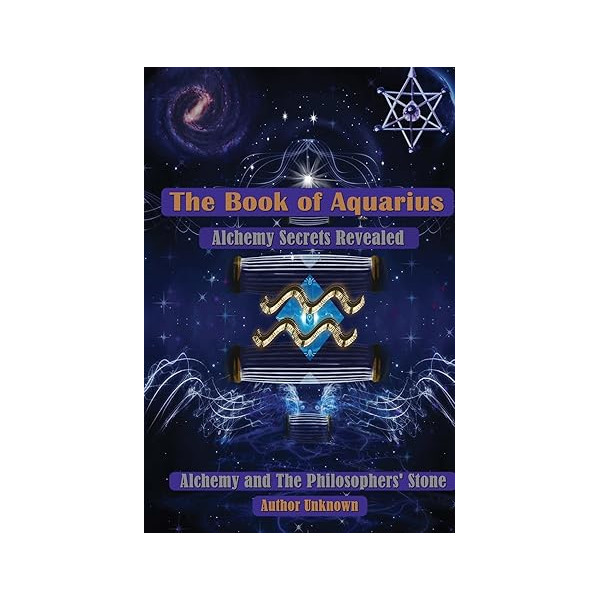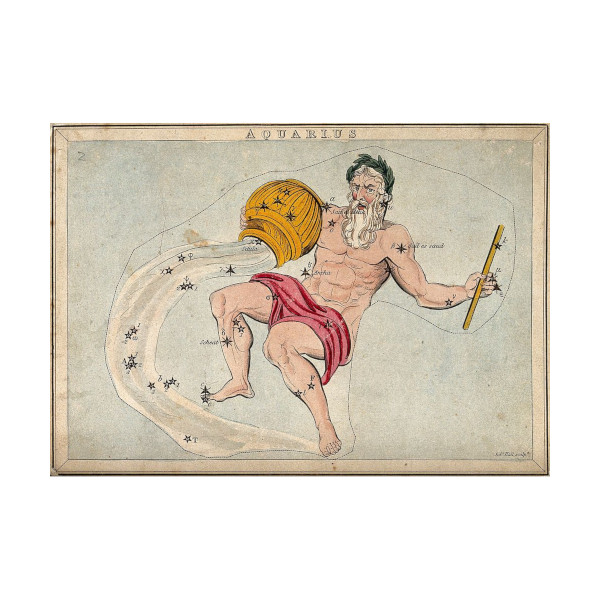Book Review: The Book of Aquarius (2011)

Book Review: The Book of Aquarius (2011)
Introduction
The Book of Aquarius, an anonymously written text on alchemy, was first published in 2011 and quickly attracted attention due to its bold premise: the genuine formula for creating the fabled Philosopher’s Stone is real, and the author claims to reveal it in full. With its widespread availability online, the book offers itself up as a spiritual, philosophical, and practical guide to anyone interested in achieving this ancient alchemical feat. Its core message is both simple and provocative: the Philosopher’s Stone, long regarded as a myth or metaphor, is in fact real and can be produced through a physical, straightforward process that’s accessible to modern readers.
The book’s mysterious origins and its promise to deliver a hands-on guide to one of history’s most elusive and myth-laden mysteries have sparked much curiosity and debate. In this review, we will explore the contents of The Book of Aquarius, assess its alchemical claims, and provide a concise breakdown of the method it proposes for creating the Philosopher’s Stone.
Summary of the Contents
The Book of Aquarius is structured as a practical guide with philosophical undertones. The anonymous author believes that ancient alchemists had once discovered the secret to the Philosopher’s Stone and that the knowledge has been preserved, albeit through cryptic allegory, for centuries. This secret, they claim, has been hidden in plain sight within the writings of classical alchemists like Paracelsus and Nicholas Flamel. However, over time, the cryptic language used by these early alchemists has confused modern scholars, causing the true knowledge to be lost or dismissed as metaphor.
The central focus of the book is to demystify alchemical texts and reveal the real, practical steps necessary for the transmutation of base metals into gold, as well as the creation of the Philosopher’s Stone—a substance said to provide immortality, spiritual enlightenment, and the ability to heal all illnesses.
While the book extensively deals with the practical alchemical process, it also delves into philosophical discussions on the nature of reality, spirituality, and human existence. The author holds that the Philosopher’s Stone is more than just a material object but a metaphor for personal transformation and enlightenment. However, this is not the main focus of the text; it is clearly a manual aimed at those interested in the physical creation of the Stone.
Structure and Key Themes
The book is divided into several chapters, each of which builds on alchemical theory while also providing step-by-step instructions for the process of creating the Philosopher’s Stone.
- Introduction to Alchemy:
- The first few chapters introduce alchemy as a legitimate science and explain how it has been misunderstood throughout history. The author makes a case for the reality of alchemical transformations and the possibility of creating physical gold and the Philosopher’s Stone.
- The book draws on a wide array of historical sources, from classical texts to medieval writings, interpreting them in a literal sense rather than the symbolic way most scholars approach these writings.
- Materials and Tools:
- The author details the basic materials required for the alchemical process. Surprisingly, the ingredients for the Philosopher’s Stone are described as common and readily available in nature. According to The Book of Aquarius, the main ingredient is human urine, which is said to contain the “First Matter” or “Prima Materia,” a critical component in the creation of the Stone.
- The tools necessary for the process are described as simple and accessible, making it clear that the alchemical process is meant to be undertaken by the layperson, not an elite scientist or mystic.
- The Process:
- The book provides detailed, sequential instructions on how to begin the alchemical process. This includes the fermentation of the Prima Materia (urine), followed by multiple stages of refinement, purification, and transformation.
- The alchemical process described in The Book of Aquarius is divided into several stages, which correspond to classical alchemical symbolism: nigredo (blackening or decomposition), albedo (whitening or purification), and rubedo (reddening or perfection). These phases mark the transformation of the Prima Materia into the Philosopher’s Stone, paralleling the personal transformation of the alchemist.
- Philosophical and Spiritual Insights:
- Beyond its practical advice, the book also delves into philosophical reflections on the significance of the Philosopher’s Stone. According to the author, creating the Stone is not just about making physical gold or gaining immortality, but also about achieving spiritual transformation. The process is said to mirror the internal transformation of the individual, with the goal of attaining a higher state of consciousness and oneness with the universe.
- The author suggests that the alchemical journey is deeply personal and connected to one’s spiritual growth. By engaging in the creation of the Philosopher’s Stone, the alchemist undergoes a parallel process of spiritual refinement, culminating in enlightenment or the realization of true wisdom.
- Historical and Mythical Context:
- The book draws on historical references and alchemical texts to demonstrate that the Philosopher’s Stone is more than just a myth. The author frequently cites figures like Hermes Trismegistus, Paracelsus, and Nicholas Flamel, offering new interpretations of their work and linking them to the process outlined in the book.
- The text argues that many of the myths surrounding the Philosopher’s Stone, such as its ability to grant immortality or transmute base metals into gold, are literal truths that can be achieved through alchemy.
- Criticism of Modern Science:
- A recurring theme in The Book of Aquarius is the author’s critique of modern science. The book argues that science has become too rigid and dismissive of ancient wisdom, particularly in its rejection of alchemy as pseudoscience. The author asserts that modern materialism blinds humanity to deeper spiritual truths, and that by reviving alchemical practices, we can reconnect with a more holistic understanding of the universe.
The Method for Creating the Philosopher’s Stone
One of the most intriguing aspects of The Book of Aquarius is the method it proposes for creating the Philosopher’s Stone. The author claims that the process is simple, though lengthy, and can be done using basic materials and equipment.
The steps, as outlined in the book, can be summarized as follows:
- Collecting Urine:
- The primary ingredient for the Philosopher’s Stone is human urine. The author insists that urine contains all the essential components for alchemy, including the Prima Materia, which is the raw material from which the Stone is made.
- Fermentation:
- The urine is left to ferment over a long period, during which it undergoes a process of decomposition. This corresponds to the first alchemical phase known as nigredo, or blackening, symbolizing death and putrefaction.
- The author instructs the alchemist to collect a black substance that forms during this stage, which is then refined and purified over time.
- Distillation and Purification:
- The black substance is distilled and purified through various processes that are intended to separate the “impurities” from the essential components needed for the Philosopher’s Stone. This stage is often compared to the alchemical phase of albedo, or whitening, representing purification and rebirth.
- Repetition of the Process:
- The distillation and purification processes are repeated multiple times. This is described as a lengthy but necessary process that requires patience and diligence on the part of the alchemist.
- According to the book, these repeated purifications eventually lead to the creation of a white powder, which is the precursor to the Philosopher’s Stone.
- The Final Transformation:
- After completing the purification process, the white powder is subjected to further refinement, ultimately resulting in the creation of the Philosopher’s Stone. This final stage is symbolized by rubedo, or reddening, marking the completion of the alchemical work.
- Uses of the Philosopher’s Stone:
- Once the Philosopher’s Stone is created, it can be used in a variety of ways, according to the author. It can transmute base metals into gold and silver, heal diseases, and even grant immortality. However, the Stone’s most significant function is its ability to spiritually transform the individual who possesses it.
Breakdown of the Process in The Book of Aquarius
- Distillation:
- The process starts with the repeated distillation of human urine, which serves as the “Prima Materia” or the primary substance from which the Philosopher’s Stone is to be made.
- The distillate is collected as an essence (sometimes called the “Philosophical Mercury”), while the solid waste or “feces” is left behind in the distillation vessel. This essence is the volatile, purified part of the urine that will be crucial for the later stages.
- Calcination:
- The solid residue (the “feces”) that remains after distillation is calcined. Calcination involves heating the substance to a high temperature until it turns into a white or gray ash, which represents the purified form of the body after it has been reduced to its most essential form.
- Calcination serves to refine the material, removing impurities, and preparing it for recombination with the essence that was collected earlier.
- Imbibing:
- Once the calcination is complete, the essence that was distilled earlier is gradually reintroduced or “imbibed” into the calcined substance.
- This step is significant because it symbolizes the reunification of the purified body with the spirit, a core concept in alchemical thought. The essence is absorbed by the calcined ash, creating a unified material.
- Sealing and Putrefaction:
- After the recombination of the essence and the calcined material, the mixture is sealed in a vessel, and the process of putrefaction begins. In alchemy, putrefaction refers to allowing the material to decompose and transform in a controlled environment. This step corresponds to the alchemical stage of nigredo (the blackening or decomposition), where the material undergoes a symbolic “death.”
- The sealed material is heated at a gentle, consistent temperature for a prolonged period, and this allows the substance to break down and ferment further, preparing it for the subsequent stages of refinement.
- Further Stages:
- After putrefaction, the material undergoes further distillations, purifications, and transformations, following the classical alchemical phases of albedo (whitening) and rubedo (reddening) until the final creation of the Philosopher’s Stone.
- The Philosopher’s Stone is described as a substance that can transmute base metals into gold and grant health and immortality, though the process is just as much about spiritual enlightenment as it is about material transformation.
Critique and Interpretation
The Book of Aquarius presents itself as a radical departure from conventional alchemical writings by claiming to offer a simple and clear path to the Philosopher’s Stone. However, the text has been met with skepticism from both academic scholars and practicing alchemists.
One of the primary criticisms of the book is its reliance on urine as the Prima Materia. While urine has been referenced in some historical alchemical texts, it has never been universally accepted as the sole material needed for alchemical transformation. Furthermore, the book’s step-by-step process for creating the Philosopher’s Stone is difficult to verify, as there is no modern evidence of anyone successfully completing the process described.
Additionally, the philosophical aspects of the book, while intriguing, are not fully fleshed out. The author touches on profound themes of spiritual transformation but does not explore them in as much depth as some readers might hope. As a result, the book feels more like a technical manual than a spiritual guide.
Despite these criticisms, The Book of Aquarius has a certain charm and appeal for those interested in the esoteric and the mystical. It is accessible, straightforward, and written in a style that encourages readers to experiment and explore the world of alchemy for themselves. Whether or not the process it describes leads to the creation of the Philosopher’s Stone, the book serves as an interesting entry point into the world of alchemical philosophy.
Conclusion
The Book of Aquarius is a fascinating, if controversial, contribution to the modern exploration of alchemy. Its straightforward approach, claiming to provide an accessible, literal method for creating the Philosopher’s Stone, sets it apart from traditional alchemical texts that often obscure their processes behind layers of symbolism and metaphor. The anonymous author’s bold assertion that anyone can replicate this ancient practice, using common materials and following a simple procedure, challenges long-standing perceptions of alchemy as an arcane and mystical art reserved for the initiated.
Despite its controversial nature—especially in claiming that the Philosopher’s Stone can be physically created today—the book has garnered significant attention for reviving interest in alchemical practices. Whether or not the method it describes can truly deliver on the promises of transmutation and immortality, the work serves as a gateway into the rich philosophical and historical tradition of alchemy, inviting readers to explore the deeper symbolic and transformative aspects of the Great Work.
Ultimately, The Book of Aquarius appeals to both the seeker of spiritual enlightenment and the curious experimenter. It walks the line between science and mysticism, blending practical steps with the promise of profound inner change. For those willing to undertake the process, the book offers not only a recipe for the Philosopher’s Stone but also an invitation to a journey of self-discovery and transformation.
Many of you found this site after watching an episode that mentions The Book of Aquarius on The Why Files? channel. If you haven’t yet, It’s worth a watch.
You can download the free pdf here.

